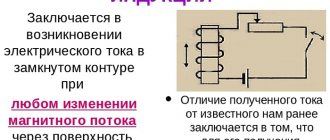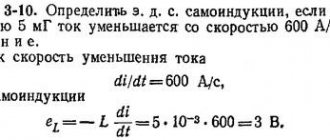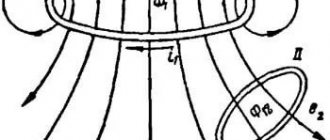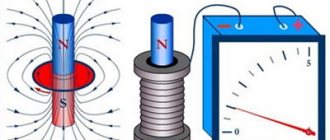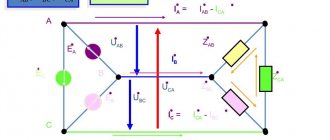A homogeneous magnetic field (MF), existing in a certain volume, is called so because it is the same at all its points. If we consider a certain plane located at right angles to the magnetic field lines, then the number of lines piercing it can be calculated. The magnetic induction flux, the formula of which was derived by the German physicist Wilhelm Weber, is the desired quantity.
Magnetic flux
What is magnetic flux
Conducting experiments and working in the field of magnetic phenomena, Weber gave a definition of magnetic flux. He characterized it as a measure of the strength and extent of the MP. This is one of the physical quantities that can be found by knowing the magnitude of the magnetic induction vector B→ (VMI). You also need to know the area of the intersecting surface and the sine of the angle between the VMI and the normal to the plane.
Units
Magnetic flux is denoted by the letter Φ and is measured in webers (Wb). The unit is named after the scientist's name. Thus, 1 Wb characterizes the magnetic flux Φ created by a magnetic field with an induction of one Tesla (1 T), penetrating a plane with an area of one square meter (1 m²), taking into account the fact that this surface is located at right angles to the VMI (V →).
Measuring instruments
Magnetic field induction
Magnetic fluxes, determined using special instruments - fluxmeters, are measured both in laboratory and field conditions. The devices are also called webermeters. A feature of such a measuring apparatus of a magnetoelectric system (MES) is that the current is supplied to a moving frameless frame through spirals that do not have a counter moment (momentless).
Attention! At the moment when there is no current, the instrument pointer does not have a fixed position within the scale.
Scheme of application and device of a flux meter
The device consists of the following parts, marked in Fig. higher:
- permanent magnet under test – 1;
- measuring frame – 2;
- device frame – 3;
- device magnet – 4;
- correction device frame – 5;
- adjustment head for the correction frame – 6;
- switch “work - correction” – 7.
A flux meter cannot measure weak MFs due to low sensitivity.
Gauss's theorem for magnetic induction
What is the source of the magnetic field
The great German scientist Carl Gauss, who distinguished himself in mathematics, physics and astronomy, derived a law (theorem) in the field of magnetism. He proved that, unlike the electric field created by electric charges, the magnetic field is not created by magnetic charges. They simply do not exist in classical electrodynamics.
Information. The theorem that Gauss derived belongs to the main laws of electrodynamics and is part of Maxwell's system of equations. It describes the relationship between the flow of electric field intensity penetrating a closed arbitrary surface and the sum of charges placed in the volume outlined by this surface. The sum is expressed in algebraic form.
In relation to magnetic induction, the flux B→ passing through the closed surface S has a zero value.
Magnetic induction vector flux
Magnetic flux quantization
In 1961, it was practically established that if a magnetic flux is directed through a looped superconductor through which electricity flows, then the value of Φ will be a multiple of the flux quantum Φ0 = h/2e = 2.067833758*10-15 Wb. This is the SI value.
Magnetic induction vector: formula
This experiment was carried out by the Americans Deaver and Fairbank. They performed quantization using a hollow tube, passing circular currents of a superconducting nature through it. Their result of quantum dimension was two times smaller. This was due to the fact that electrons in a superconducting situation split into pairs. The particles formed twos with a charge of 2e. It is the movement of these pairs that constitutes the nature of superconducting current.
For your information. Superconductors are materials whose resistance drops sharply when the temperature drops to a certain value. It is practically equal to zero, then we can talk about superconducting properties. Metals that are excellent conductors - gold, silver, platinum - do not acquire superconducting abilities under such conditions.
Magnetic flux quantization
Magnetic field strength
Tension Formula
Have you ever heard the expression: “the tension between them grew and grew.” That is, in essence, tension is something invisible, some kind of restraining force, energy. Almost everything is the same here. Magnetic field strength is also often called magnetic field strength. The magnetic field strength directly depends on the magnetic flux density and is expressed by the formula
Where
H—magnetic field strength, Ampere/meter
B—magnetic flux density, Tesla
μ0 - magnetic constant = 4π × 10-7 Henry/meter or, in human terms, 1.2566 × 10-6 Henry/meter.
PS.
This formula only works when there is air or vacuum between the turns of the coil. A cooler formula looks like this.
Where
μ is the relative magnetic permeability.
It is different for different substances
Magnetic field strength of a current-carrying conductor
So, we have some kind of conductor through which electric current flows.
In order to calculate the magnetic field strength at a certain distance from the conductor, provided that the conductor is in air space or in a vacuum, it is enough to use the formula
Where
H—magnetic field strength, Ampere/meter
I - current flowing through the conductor, Ampere
r - distance to the point at which the tension is measured, meter
Permanent magnets
Permanent magnets can serve as a source of magnetic field (MF). They are made from magnetite. In nature it is known as iron oxide. This is a black mineral with the molecular structure of FeO·Fe2O3. The properties of magnets have been known since ancient times. Magnets have two poles - north and south.
Permanent magnets can be classified according to the following criteria:
- the material from which the magnet is made;
- form;
- scope of use.
Permanent pole magnets are made from various materials:
- ferrites - pressed products from iron oxide powders and oxides of other metals;
- rare earth - nodimium (NdFeB), samarium (SmCo), cast (metal alloys), polymer (magnetic plastics).
The shape of magnets is very different:
- cylindrical (rectangular);
- horseshoe-shaped;
- ring-shaped;
- disc-shaped.
Important! Depending on the shape, the location of the poles changes, and accordingly, the direction of the magnetic lines near the field changes.
Direction of MF lines depending on the shape of the magnet
Permanent magnets have found wide application in various sectors of the national economy:
- MRI is a medical device for diagnosing the human body;
- hard disk drives in modern computers;
- in radio engineering, in the manufacture of speakers;
- production of decorative jewelry using polymer-based magnets.
In DC motors, such magnets are mounted in the inductor housing.
Conducting research on the induction phenomenon
In the first series of experiments, Michael Faraday inserted a magnetized metal bar into a coil connected to a current, and then took it out (Fig. 1, 2).
1 2
When a magnet is placed in a coil connected to a measuring instrument, an induced current begins to flow in the circuit. If the magnetic bar is removed from the coil, the induced current still appears, but its direction becomes the opposite. Consequently, the parameters of the induction current will change in the direction of movement of the bar and depending on the pole with which it is placed in the coil. The current strength is influenced by the speed of movement of the magnet.
The second series of experiments confirms the phenomenon in which a changing current in one coil causes an induced current in another coil (Fig. 3, 4, 5). This happens when the circuit closes and opens. The direction of the current will depend on whether the electrical circuit closes or opens. In addition, these actions are nothing more than ways to change the magnetic flux. When the circuit is closed, it will increase, and when it opens, it will decrease, simultaneously penetrating the first coil.
3 4
5
As a result of experiments, it was found that the occurrence of an electric current inside a closed conducting circuit is possible only when they are placed in an alternating magnetic field. In this case, the flux of magnetic field induction can change over time in any way.
The electric current that appears under the influence of electromagnetic induction is called induction, although it will not be a current in the generally accepted sense. When a closed circuit is placed in a magnetic field, an emf with a precise value is generated, rather than a current that depends on different resistances. This phenomenon is called induced emf, which is reflected by the formula: Eind = – ∆Ф/∆t. Its value coincides with the rate of change of the magnetic flux penetrating the surface of a closed loop taken with a negative value. The minus present in this expression is a reflection of Lenz's rule.
Electromagnets
The next type of device designed to create an MF is an electromagnet. When electric current flows through its winding, the core becomes a magnet. Consequently, the electromagnet consists of the following parts:
- core (magnetic circuit);
- winding.
This is a kind of inductor called a solenoid.
The core can be made of ferrimagnetic material or a sheet of electrical steel.
The winding is wound with aluminum or copper wire covered with insulation.
Electromagnets (EM) can be classified according to the following parameters:
- DC magnets – neutral;
- DC magnets – polarized;
- AC devices.
Neutral EM - the creation of a magnetic flux occurs in such a way that the magnitude of attraction increases with increasing current strength and does not obey the direction of movement of the electrons.
Polarized EMs contain:
- working winding - to create a working Φ;
- permanent magnet – for inducing polarizing Φ.
The EM AC windings are powered by a sinusoidal current, so their Φ changes according to a periodic law.
Appearance of the simplest EM
Electromagnetic induction
Michael Faraday discovered a phenomenon known as electromagnetic induction. In 1831, it was noticed that if the magnetic flux Φ, which penetrates a circuit made of a closed conductor, is changed, an electric current is induced in it.
Attention! The magnitude of the electromotive force (EMF) arising in this case does not depend on the reason for the change in Φ, but is proportionally related to the change in its speed through the surface within the contour.
Electromagnetic induction
Self-induction
Self-induction is the phenomenon of the occurrence of induced emf in a conductor as a result of a change in current in it.
When the current in the coil changes, the magnetic flux created by this current changes. A change in the magnetic flux passing through the coil should cause the appearance of an induced emf in the coil.
In accordance with Lenz's rule, the self-inductive emf prevents the current from increasing when the circuit is turned on and the current from decreasing when the circuit is turned off.
This leads to the fact that when a circuit is closed in which there is a current source with a constant EMF, the current strength is established after some time.
When the source is turned off, the current also does not stop instantly. The self-inductive emf that arises in this case may exceed the source emf.
The phenomenon of self-induction can be observed by assembling an electrical circuit from a coil with high inductance, a resistor, two identical incandescent lamps and a current source. The resistor must have the same electrical resistance as the coil wire.
Experience shows that when the circuit is closed, an electric lamp connected in series with a coil lights up somewhat later than a lamp connected in series with a resistor. The increase in current in the coil circuit during closure is prevented by the self-induction emf, which occurs when the magnetic flux in the coil increases.
When the power source is turned off, both lamps flash. In this case, the current in the circuit is maintained by the self-induction emf that occurs when the magnetic flux in the coil decreases.
Self-inductive emf \( \varepsilon_{is} \), arising in a coil with inductance \( L \), according to the law of electromagnetic induction is equal to:
The self-inductive emf is directly proportional to the inductance of the coil and the rate of change of current in the coil.
Right hand rule
The “right hand rule” helps determine in which direction the induced current will move. The decoding of this method, invented for memorization, is as follows:
- the right hand is placed in the MP so that the palm is located at an angle of 90° to the magnetic lines of force;
- the thumb is directed in the direction of movement of the conductor.
The induced current moves where the four fingers of the hand point.
Right hand rule
Magnetomotive force (MF).
Despite the fact that the electric current in a wire and its magnetic field are inseparable aspects of a single electromagnetic process, it is customary to say that electric current has the property of exciting a magnetic field. This property of current is called magnetomotive force (MF) and is denoted by the letter F.
Formally, the MMF F causes or excites a magnetic field in the same way that an emf causes an electric current in an electrical circuit.
In the International System of Units, the MMF is taken to be numerically equal to the current in a wire or coil causing a magnetic field, so that MMF F=l. If a current passes through a coil with the number of turns w, then the MMF is equal to the product of the current and the number of turns, i.e. Naturally, the MMF, like the current, is measured in amperes, i.e. To determine the direction of the MMF of the coil or turn c When using current, it is convenient to use the rule of the right hand: if you grasp the coil (turn) with your right hand so that its four fingers are located in the direction of the current in the turns of the coil, then the bent thumb will indicate the direction of the MMF. In Fig. Figure 1 shows several coils with current and the directions of their MMF.
Fig. 1 Determining the direction of the MMF in a coil with current.
Rice. 2 Magnetic voltage between two points
Magnetic flux: formula
Determining the value of Φ is possible using mathematical calculation. The magnetic flux formula is:
Φ = B*S*cos α,
Where:
- B – magnetic induction vector (VMI);
- S – contour area;
- cos α is the angle between the VMI and the perpendicular (normal) to the intersecting surface.
Here, B is the magnitude of the magnetic induction vector.
Explanation of the formula for determining the value of Φ
Multiples and submultiples of tesla:
Multiples and submultiples are formed using standard SI prefixes.
| Multiples | Dolnye | ||||||
| magnitude | Name | designation | magnitude | Name | designation | ||
| 101 T | decatesla | yesTl | daT | 10−1 T | decitesla | dTl | dT |
| 102 T | hectotesla | gTl | hT | 10−2 T | centitesla | stl | cT |
| 103 T | kilotesla | kT | kT | 10−3 T | millitesla | mTl | mT |
| 106 T | megatesla | MTL | M.T. | 10−6 T | microtesla | µT | µT |
| 109 T | gigatesla | GTL | GT | 10−9 T | nanotesla | nTl | nT |
| 1012 T | teratesla | TTL | TT | 10−12 T | picotesla | pTl | pT |
| 1015 T | petatesla | PTl | P.T. | 10−15 T | femtotesla | ftl | fT |
| 1018 T | exatesla | ETL | ET | 10−18 T | attotesla | atl | aT |
| 1021 T | zettatesla | ZTL | ZT | 10−21 T | zeptotesla | ztl | zT |
| 1024 T | iottatesla | ITl | YT | 10−24 T | ioctotesla | iTl | yT |
Formula for the rate of change of magnetic flux
Based on the rate of change of magnetic fluxes through the circuit, the magnitude of the EMF induced in the circuit is determined. The speed Ei itself will be determined by the formula:
Ei = — ∆ Φ/∆t,
Where:
- ∆ Φ = Φ2 – Φ1 – change in flow (Wb);
- ∆t – change in time (s).
The unit of measurement for speed is Wb/s.
Faraday's discovery of the law of electromagnetic induction made it possible to use the work of magnetic flux to create electrical machines: generators and motors, both direct and alternating current. In them, depending on the design, either the permanent magnet changes its position relative to the frame, or the frame rotates in the MP. One way or another, an emf arises, its value depends on Φ.
Lenz's rule
The direction of the induction current is determined by Lenz's rule : the induction current excited in a closed loop when the magnetic flux changes is always directed so that the magnetic field it creates prevents the change in the magnetic flux causing the induction current.
Algorithm for solving problems using Lenz's rule:
- determine the direction of the magnetic induction lines of the external magnetic field;
- find out how magnetic flux changes;
- determine the direction of the magnetic induction lines of the magnetic field of the induced current: if the magnetic flux decreases, then they are co-directed with the lines of the external magnetic field; if the magnetic flux increases, it is opposite to the direction of the magnetic induction lines of the external field;
- according to the gimlet rule, knowing the direction of the induction lines of the magnetic field of the induction current, determine the direction of the induction current.
Lenz's rule has a deep physical meaning - it expresses the law of conservation of energy.
Video
Coffee capsule Nescafe Dolce Gusto Cappuccino, 3 packs of 16 capsules
1305 ₽ More details
Coffee capsules Nescafe Dolce Gusto Cappuccino, 8 servings (16 capsules)
435 ₽ More details
QLED TVs


